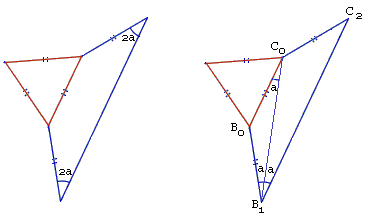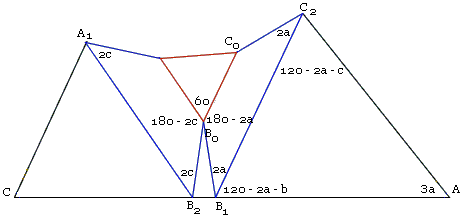Morley's Theorem
G. Zsolt Kiss' proof
This is the latest proof that was sent (September 02, 2006) to me by G. Kiss Zsolt from Hungary. Like Conway's and Newman's, this one, too, employs the cheating (backward) strategy. Also, one can't miss its relation to Conway's proof. It uses the same add-ons but in a more natural and symmetric manner.
Assume angles a, b, c are given such that a + b + c = 60°. Pick up an equilateral triangle and, on its sides form isosceles trapezoids with base angles 2a, 2b, 2c, respectively, and the sides equal to the top base.

In such a trapezoid B0B1C2C0, the diagonals serve as the bisectors of the base angles. Indeed, assuming
Now we form ΔABC by passing three straight lines through the dangling vertices of the trapezoids:

We get three small isosceles triangles, ΔB0B1B2 is one of them. Its apex angle B1B0B2 is found from
| ∠B1B0B2 | = 360° - 60° - (180° - 2a) - (180° - 2c) |
| = 2a + 2c - 60° | |
| = 2(60° - b) - 60° | |
| = 60° - 2b. |
Hence its base angles equal
while the supplementary angle
It follows that ∠C0B1A = 120° - a - b so that the two sum up to 180°:
This means that quadrilateral AC2C0B1 is cyclic. In the same manner, quadrilateral AC0B0B1 is also cyclic. Hence so is the pentagon AC2C0B0B1. Since, in the circumcircle, the three chords B0B1, B0C0, and C0C2 are equal, lines AB0 and AC0 trisect angle at A, which, as easily seen is 3a.
Now trying to reverse the steps, assume in ΔA'B'C' angles equal 3a, 3b, 3c so that
Compared to Conway's or Newman's, it may be just a little longer but does not come even close to using trigonometry.
Hubert Shutrick sent me the following comment (with the entire proof on a separate page):
The third diagram in the proof shows how the vertices of ΔABC can be constructed using the points A1, A2, B1, B2, C1, C2 although A2 and C1 are not shown. Here is another motivation for these six points. Note that it is a straight edge and compass construction. Given the equilateral triangle A0B0C0, the required vertex A has to be such that the angle B0AC0 is a and the locus of points making this angle is the arc of a circle through B0 and C0. Any other chord of the same length will also subtend the angle a for points on the circle. That is why B1 is an interesting point. The angle B0B1C0 is a so B1 is on the circle and, since the length B0B1 is 1, the angle B0AB1 will be a for points A on the circular arc. Hence, if the theorem is true, B1 must be on the side AC of the required triangle.
By symmetry, the six points mentioned above must be on the sides of the triangle ABC. The proof then consists of showing that it's angles are indeed 3a, 3b and 3c, simple angle calculations. There are two special cases that should be mentioned. There is the case
I found this proof long ago, in the 1970s, while teaching Euclidean geometry to prospective mathematics' teachers at Karlstad's university college.
Amic has observed that a correction is in order:
I read
|
"There are two special cases that should be mentioned. There is the case |
There is a mistake : the other case is when a or b or
And I don't see why the case
So in my opinion this proof is wrong for a triangle ABC with a right angle.
My comment is that the proof can be saved by drawing the necessary line not "through two points" but at a certain angle at the "double point". For example, if
Hubert Shutrick has later added the following:
If B' is the midpoint of B1B2, then B0B' is orthogonal to AC and ∠C0B0B' is
Morley's Miracle
On Morley and his theorem
- Doodling and Miracles
- Morley's Pursuit of Incidence
- Lines, Circles and Beyond
- On Motivation and Understanding
- Of Looking and Seeing
Backward proofs
- J.Conway's proof
- D. J. Newman's proof
- B. Bollobás' proof
- G. Zsolt Kiss' proof
- Backward Proof by B. Stonebridge
- Morley's Equilaterals, Spiridon A. Kuruklis' proof
- J. Arioni's Proof of Morley's Theorem
Trigonometric proofs
- Bankoff's proof
- B. Bollobás' trigonometric proof
- Proof by R. J. Webster
- A Vector-based Proof of Morley's Trisector Theorem
- L. Giugiuc's Proof of Morley's Theorem
- Dijkstra's Proof of Morley's Theorem
Synthetic proofs
- Another proof
- Nikos Dergiades' proof
- M. T. Naraniengar's proof
- An Unexpected Variant
- Proof by B. Stonebridge and B. Millar
- Proof by B. Stonebridge
- Proof by Roger Smyth
- Proof by H. D. Grossman
- Proof by H. Shutrick
- Original Taylor and Marr's Proof of Morley's Theorem
- Taylor and Marr's Proof - R. A. Johnson's Version
- Morley's Theorem: Second Proof by Roger Smyth
- Proof by A. Robson
Algebraic proofs
Invalid proofs
|Contact| |Front page| |Contents| |Geometry|
Copyright © 1996-2018 Alexander Bogomolny
73589141
